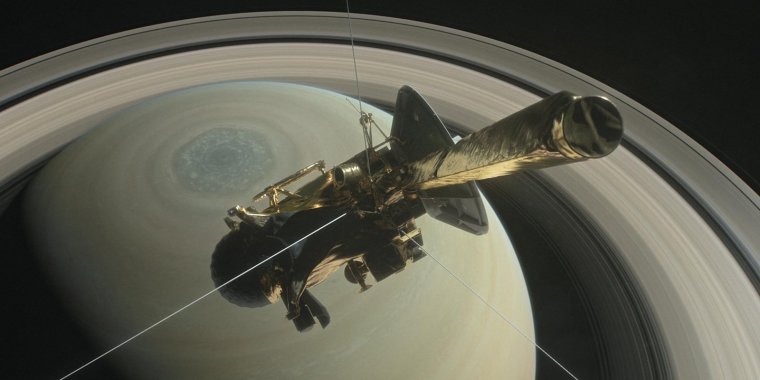| News / Space News |
Cassini Spacecraft Makes Its Final Approach to Saturn
NASA's Cassini spacecraft is on final approach to Saturn, following confirmation by mission navigators that it is on course to dive into the planet's atmosphere on Friday, Sept. 15.

The spacecraft will make a final plunge into the planet's atmosphere on Sept. 15. ![]()
Cassini is ending its 13-year tour of the Saturn system with an intentional plunge into the planet to ensure Saturn's moons - in particular Enceladus, with its subsurface ocean and signs of hydrothermal activity - remain pristine for future exploration.
The spacecraft's fateful dive is the final beat in the mission's Grand Finale, 22 weekly dives, which began in late April, through the gap between Saturn and its rings. No spacecraft has ever ventured so close to the planet before.
The mission's final calculations predict loss of contact with the Cassini spacecraft will take place on Sept. 15 at 7:55 a.m. EDT (4:55 a.m. PDT).
Cassini will enter Saturn's atmosphere approximately one minute earlier, at an altitude of about 1,190 miles (1,915 kilometers) above the planet's estimated cloud tops (the altitude where the air pressure is 1-bar, equivalent to sea level on Earth).
During its dive into the atmosphere, the spacecraft's speed will be approximately 70,000 miles (113,000 kilometers) per hour. The final plunge will take place on the day side of Saturn, near local noon, with the spacecraft entering the atmosphere around 10 degrees north latitude.
When Cassini first begins to encounter Saturn's atmosphere, the spacecraft's attitude control thrusters will begin firing in short bursts to work against the thin gas and keep Cassini's saucer-shaped high-gain antenna pointed at Earth to relay the mission's precious final data.
As the atmosphere thickens, the thrusters will be forced to ramp up their activity, going from 10 percent of their capacity to 100 percent in the span of about a minute. Once they are firing at full capacity, the thrusters can do no more to keep Cassini stably pointed, and the spacecraft will begin to tumble.
When the antenna points just a few fractions of a degree away from Earth, communications will be severed permanently. The predicted altitude for loss of signal is approximately 930 miles (1,500 kilometers) above Saturn's cloud tops.
From that point, the spacecraft will begin to burn up like a meteor. Within about 30 seconds following loss of signal, the spacecraft will begin to come apart; within a couple of minutes, all remnants of the spacecraft are expected to be completely consumed in the atmosphere of Saturn. (NASA)
YOU MAY ALSO LIKE


